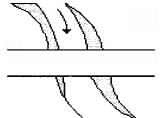Test: Surveying- 1 - Civil Engineering (CE) MCQ
25 Questions MCQ Test Civil Engineering SSC JE (Technical) - Test: Surveying- 1
To avoid large centering error with very short legs, observations are generally made
Which of the following methods of theodolite traversing is suitable for locating the details which are far away from transit stations?
The line of collimation method of reduction of levels, does not provide a check on
Which of the following methods of contouring is most suitable for a hilly terrain?
If the reduced bearing of a line AB is N60°W and length is 100 m,then the latitude and departure respectively of the line AB will be
A lemniscate curve between the tangents will be transitional throughout if the polar deflection angle of its apex, is
The smaller horizontal angle between the true meridian and a survey line, is known
Check lines (or proof lines) in Chain Surveying, are essentially required
After fixing the plane table to the tripod, the main operations which are needed at each plane table station are
(i) Levelling
(ii) Orientation
(iii) Centering
The correct sequence of these operations is
There are two stations A and B. Which of the following statements is correct?
In direct method of contouring, the process of locating or identifying points lying on a contour is called
If the smallest division of a vernier is longer than the smallest division of its primary scale, the vernier is known as
|
2 videos|122 docs|55 tests
|



















